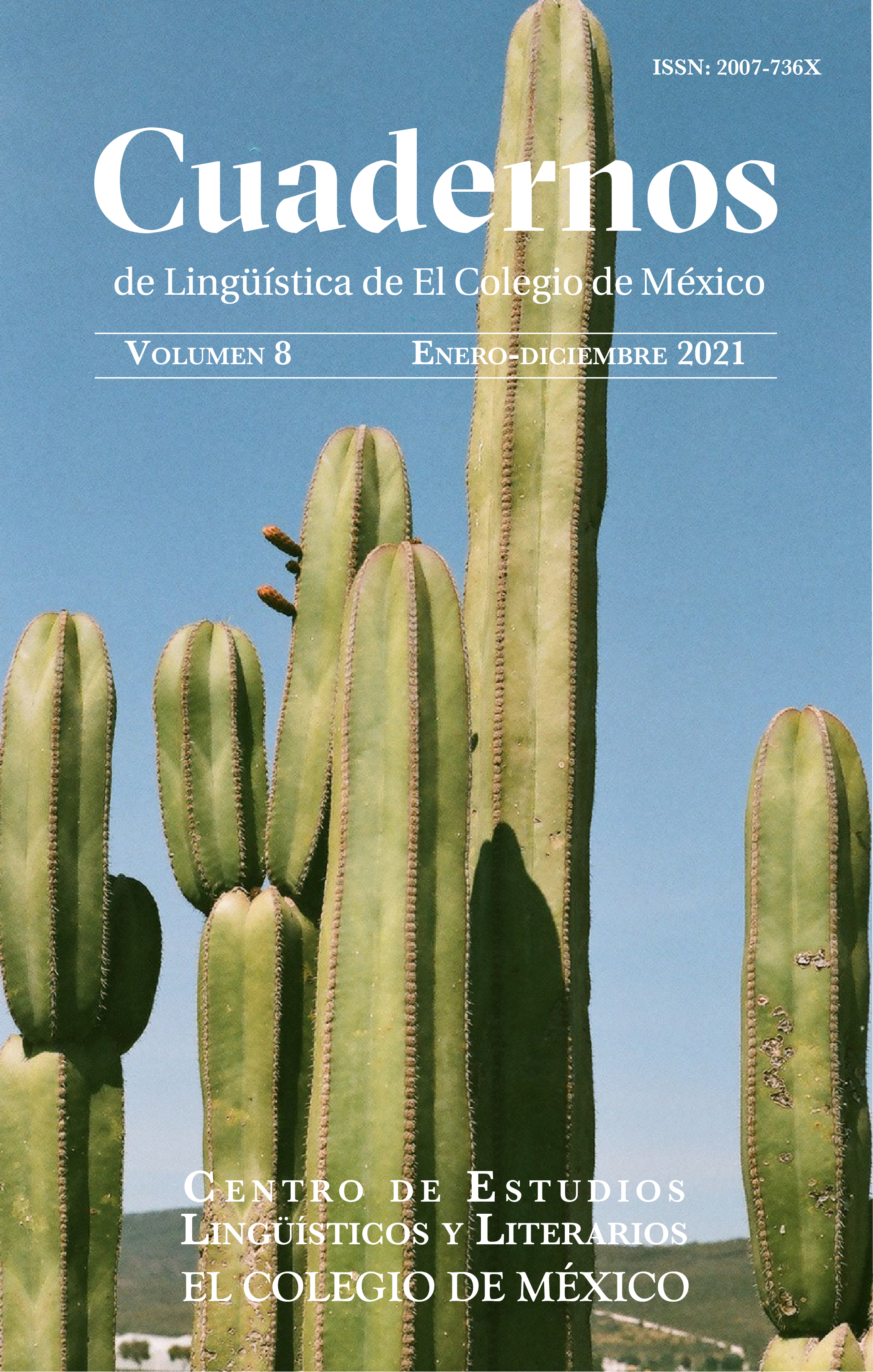Defectivity and lexicalization in morphological paradigms: the case of the morpheme –sun from Ayacucho Quechua
DOI:
https://doi.org/10.24201/clecm.v8i0.194Keywords:
Syntax, speech acts, Quechua, morphology, defectivenessAbstract
This study provides a discussion on the morpheme -sun of Ayacucho Quechua dialect, which is used for the exhortative and inclusive first-person future, and, at the same time, for marking second-person objects. Our proposal is that this morpheme has filled a gap in the verb inflection paradigm, as a result of the need for the system to mark the syntactic function of Object and the salience of the Addressee feature. Thus, Quechua uses this morpheme for two different domains in the syntax: domain of the Speech Act, in the case of the exhortative; and domain of the event, the case of the second-person object marking. Furthermore, I will open a discussion on the diachrony of this morpheme, which due to the degree of complexity of the Speech Acts morpheme system, may have been the origin of the defective morpheme in the person transition paradigm; however, I will not reach conclusive answers in this regard.
Downloads
References
Adelaar, Willem F. H. 2009. Inverse markers in Andean languages: A comparative view. LOT Occasional Series. 13. 171–185.
Adelaar, Willem F. H. & Muysken, Peter C. 2004. The languages of the Andes. Nueva York: Cambridge University Press. Alderetes, Jorge. 2001. El quichua de Santiago del Estero. Gramática y vocabulario. San Miguel de Tucumán: Universidad Nacional de Tucumán.
Alcázar, Asier & Saltarelli, Mario. 2014. The syntax of imperatives. Cambridge: Cambridge University Press.
Baker, Mark. 1985. The mirror principle and morphosyntactic explanation. Linguistic Inquiry. 16(3). 373–415.
Carlson de Coombs, Heidi. 1975. Sufijos de persona en quechua de Ayacucho. Datos etnolingüísticos Nº5. Lima: ILV-ministerio de Educación.
Cerrón Palomino, Rodolfo. 1987. La flexión de número y persona en el Protoquechua. Elsevier 9(1). 77-89.
Cusihuamán, Antonio. 1976. Gramática quechua: Cusco-Collao. 2da. ed. Cusco: Centro de Estudios Regionales Andinos “Bartolomé de las Casas”.
Ebina, Daisuke. 2012. Object in Cusco Quechua. En Watari Nakamura & Ritsuko Kikusawa (eds.), Objectivization and subjectivization: A Typology of Voice Systems. Senri Ethnological Studies. 77: 209–220.
Escandell, Victoria. 2010. Futuro y evidencialidad. Anuario de Lingüística Hispánica. XXVI. 9–34.
Gálvez Astorayme, Isabel. 1990. Quechua ayacuchano. Primer curso. Lima: Editorial Extramuros.
Harley, Heidi & Ritter, Elizabeth 2002. Person and number in pronouns: A feature-geometric analysis. Language 78: 482-526.
McGinnis, Martha 1999. Is there Syntactic Inversion in Ojibwa? En Papers from the Workshop on Structure & Constituency in Native American Languages, ed. L. Bar-el, R.-M. Déchaine & C. Reinholtz. MIT Occasional Papers in Linguistics 17. MIT Working Papers in Linguistics. 101–118.
Myler, Neil. 2016. Cliticization feeds agreement: A view from Quechua. Nat Lang Linguist Theory. DOI 10.1007/s11049-016-9351-y
Nevins, Andrew. 2011. Multiple agree with clitics: person complementarity vs. omnivorous number. Natural Language and Linguistic Theory 29(4). 939–971.
Parker, Gary J. 1976. Gramática quechua: Áncash-Huaylas. Lima: Ministerio de Educación.
Parker, Gary J. 1969. Ayacucho Quechua grammar and dictionary. París: Mouton.
Sims, Andrea D. 2006. Minding the gaps. Inflectional defectiveness in a paradigmatic theory. Ohio: The Ohio State University. (Tesis doctoral.)
Shimelman, Aviva. 2017. A grammar of Yauyos quechua. Berlín: Language Science Press.
Speas, Peggy & Tenny, Carol. 2003. Configurational properties of point of view roles. En Anna Maria Di Sciullo (ed.), Asymmetry in grammar, 315–43. Ámsterdam: John Benjamins.
Soto-Ruíz, Clodoaldo. 1976. Gramática quechua Ayacucho-Chanca. Lima: Ministerio de Educación.
Taylor, Gerald, (1982). Breve presentación de la morfología del quechua de Ferreñafe. Lexis (6)2. 243–270.
Torero, Alfredo. 2007. El quechua y la historia social andina. Lima: Fondo Editorial Pedagógico San Marcos.
Weber, David John. 1989. A grammar of (Huanuco) Huallaga quechua. Londres: The University of California Press.
Wroughton, John. 1996. Gramática y textos del quechua shaushahuanca. Pucallpa: Ministerio de Educación-ILV.
Zariquiey, Roberto & Córdova, Gavina. 2008. Qayna, kunan, paqarin. Una introducción práctica al quechua chanca. Lima: PUCP.
Zwicky, Arnold & Pullum, K. Geoffrey. 1989. Cliticization vs. inflection: English N’T. Language 59(3). 502—513.
Published
How to Cite
-
Abstract767
-
PDF (Español)305
-
XML (Español)17
-
EPUB (Español)62
-
Kindle (Español)80
-
MP3 (Español)25
Issue
Section
License
Copyright (c) 2021 Víctor Arturo Martel Paredes

This work is licensed under a Creative Commons Attribution-NonCommercial-NoDerivatives 4.0 International License.
Authors retain copyright of their work and are free to disseminate it, make copies for any use, and/or deposit in any repository or archive of their choice, but they grant Cuadernos de Lingüística de El Colegio de México the right to publish the work for the first time. Authors agree to acknowledge Cuadernos de Lingüística de El Colegio de México as the site of original publication of their article / note / review through proper citation.
Articles appearing in Cuadernos de Lingüística de El Colegio de México are made available to readers under a Attribution-NonCommercial-NoDerivatives 4.0 International.









